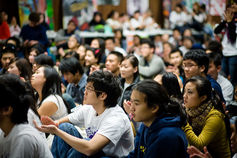By Michelle S. Moses, Professor of Educational Foundations, Policy, and Practice, University of Colorado;
Christina Paguyo, Post Doctoral Fellow, Colorado State University; and
Daryl Maeda, Associate Professor of Ethnic Studies, University of Colorado.
The Conversation, August 6, 2017 —

Protest against racial quotas during a rally outside the Supreme Court in Washington in 2015. AP Photo/Jacquelyn Martin
Media reports have stated that the Justice Department under President Donald Trump is planning to investigate a complaint of discrimination against Harvard University brought by a coalition of Asian-American groups.
From our perspective as scholars who study affirmative action, race and diversity in higher education, the complaint reflects a flawed understanding of race-conscious education policies like affirmative action.
How do affirmative action policies work, and whom do they affect?
Fisher case
Let’s first look at the legal wrangling that has been going on for some time on this issue. Since the 1978 Regents of the University of California v. Bakke case, the Supreme Court consistently has affirmed that under certain conditions (e.g., no numerical set-asides or quotas, diversity is a compelling interest) it is constitutional for institutions of higher education to consider a student’s race in admissions processes.
Most recently, in a landmark judgment on June 23, 2016, the U.S. Supreme Court upheld the constitutionality of race-conscious affirmative action in university admissions in the Abigail Fisher case.
Fisher, a white woman, had sued the University of Texas at Austin (UT Austin) for its race-conscious admissions policy after she was denied admission. She had argued that the university violated the equal protection clause of the 14th Amendment.
Supporters of race-conscious admissions programs were understandably gratified. But as the recent discussion about affirmative action demonstrates, the case did not resolve the larger moral and political disagreements over affirmative action.
Indeed, over the last 40 years, affirmative action opponents have repeatedly strategized anew after important Supreme Court decisions in favor of affirmative action.
Harvard lawsuit
It is perhaps no coincidence that Edward Blum, Abigail Fisher’s adviser and the executive director of the Project on Fair Representation, is the one leading the most recent court challenge to affirmative action, the lawsuit challenging Harvard University’s race-conscious admissions policy. What is different about the Harvard lawsuit is that the lead plaintiff in the case is not a white student but Asian-American.

Asian-Americans participate in an Advancing Justice conference. Advancing Justice Conference, CC BY-NC-SA
“Students for Fair Admissions,” an arm of the Project on Fair Representation, filed a suit against Harvard College on Nov. 17, 2014, on behalf of a Chinese-American applicant who had been rejected from Harvard. The lawsuit charges that the university’s admissions policy violates Title VI of the Civil Rights Act of 1964, which bars federally funded entities from discriminating based on race or ethnicity.
How it started
This controversy over how Asian-Americans are being treated in selective college admission was jump-started in 2005, when sociologists Thomas Espenshade and Chang Chung published findings from their study on the effects of affirmative action bans on the racial and ethnic composition of student bodies at selective colleges and universities.
Espenshade and Chung found that if affirmative action were to be eliminated, the acceptance rates for black and Latino applicants would likely decrease substantially, while the acceptance rate for white applicants would increase slightly.
But more than that, what they noted was that the acceptance rate for Asian-American applicants would increase the most by far.
As the researchers explained, Asian-American students “would occupy four out of every five seats created by accepting fewer African-American and Hispanic students.”
Such research has been cited to support claims of admissions discrimination against Asian-Americans.
In the complaint against Harvard, Espenshade’s research was cited as evidence of discrimination against Asian-Americans. Specifically, the lawsuit cited research from 2009 in which Espenshade, this time with co-author Alexandria Radford, found that Asian-American applicants accepted at selective colleges had higher standardized test scores, on average, than other accepted students.

Are elite institutions discriminating against Asian-Americans in their admissions process? Kevin Lamarque/Reuters
These findings, especially that Asian-American applicants seem to need a higher SAT score than white applicants or other applicants of color in order to be admitted to a selective college, are being used as proof that elite institutions like Harvard are discriminating against Asian-Americans in their admissions processes.
The picture is more complicated
Selective admissions processes are much more complicated than SAT score data can show. There are many factors that are taken into consideration for college admission.
For example, in the “holistic” admissions processes endorsed by the Supreme Court in Grutter v. Bollinger, standardized text scores are not the only, or even the main, criterion for admission. “Holistic” reviewtakes many relevant factors into account, including academic achievement, of course, but also factors such as a commitment to public service, overcoming difficult life circumstances, achievements in the arts or athletics, or leadership qualities.
So, why would the plaintiff in the Harvard case conclude that the disparities in SAT scores shown by Espenshade and Radford necessarily indicate that Asian-American applicants are being harmed by race-conscious affirmative action?
In fact, legal scholar William Kidder has argued that the way Espenshade and Radford’s findings have been interpreted by affirmative action opponents is not accurate.
Based on his analysis, Kidder concluded,
“Exaggerated claims about the benefits for APAs [Asian Pacific Americans] of ending affirmative action foster a divisive public discourse in which APAs are falsely portrayed as natural adversaries of affirmative action and the interests of African American and Latinos in particular.”
In our opinion as well, focusing on simplistic ideas about standardized tests as the primary evidence for who “deserves” to be admitted to elite institutions like Harvard may serve to stir up resentment among accomplished applicants who get rejected.
Asian-Americans are not a monolithic group
As the “Harvard Not Fair” website and accompanying lawsuit demonstrate, Espenshade’s findings have been used to fuel a politics of resentment among rejected Asian-American applicants.
When speaking with reporters, Espenshade himself has acknowledged that his data are incomplete – given that colleges take myriad factors into account in admissions decisions – and that his findings have been overinterpreted and actually do not prove that colleges discriminate against Asian-American applicants.

Are Asian-American students a monolithic group? Charlie Nguyen, CC BY
In addition, in using images of Asian-American students to recruit complainants against Harvard and other highly selective institutions of higher education, the Project on Fair Representation relies on the idea that Asian-Americans comprise a monolithic group. In fact, the term “Asian-American” refers to a diversity of Asian ethnicities in the United States, whose educational opportunities and achievements vary widely.
The 2010 census question on race included check boxes for six Asian groups – Asian Indian, Chinese, Filipino, Japanese, Korean and Vietnamese – along with a box for “Other Asian,” with a prompt for detailed responses such as “Hmong, Laotian, Thai, Pakistani, Cambodian, and so on.”
Furthermore, by casting plaintiffs as meritorious and deserving of a spot at an elite university, it also conveys the stereotypical received wisdom about Asian-American “model” students who are wronged by race-conscious affirmative action programs.
In actuality, many Asian-Americans benefit from affirmative action policies.
This is an updated version of an article originally published on July 14, 2016.
___________________________________________










